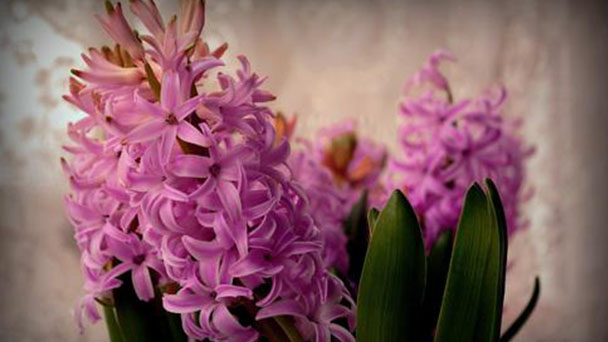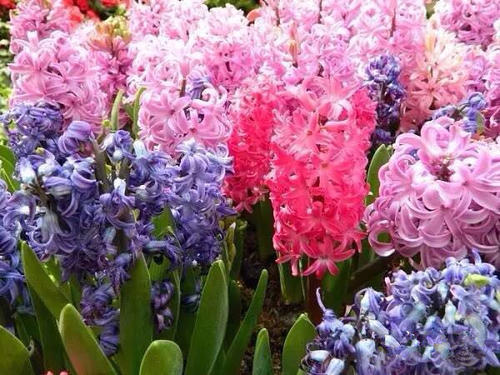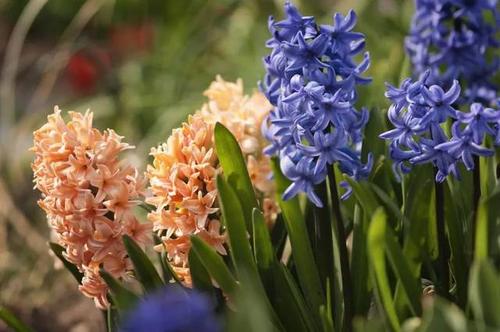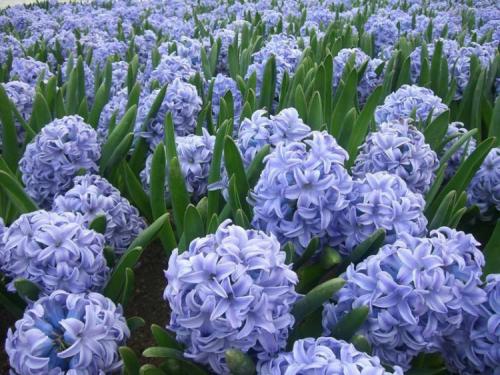How to grow and care for Hyacinth
Written by Maggie
Oct 30 2021

Hyacinth is a lily family, Hyacinth is a perennial herb. Hyacinth is very beautiful and has a mysterious and melancholy atmosphere of flowers, and Hyacinth petals are not like general flowers, its flowers are like colorful grapes in a pile together, far from a large grape. Today, we will talk about steps to grow Hyacinth and how to care for Hyacinth.

Steps to grow Hyacinth
1. Prepare all the materials that will be used in the planting process: Bulb, basin, soil, carbendazim, chicken BB, bone meal.
Check the surface of the ball for that layer of purple coat. Peel off all mildew spots, no peeling can also be,
Find a basin with half a basin of water. It is advisable to have just not planted a ball. Add 10 grams of carbendazim and mix it all together, then put the clean seeds into the bowl, let it soak for about half an hour, which plays a bactericidal role. (Because the balls are airtight during long-distance transportation, they are easy to get moldy)
4. Wash the soaked balls and take them out. Set aside to dry, waiting for planting.
5. Find the right flower pot. In general, 1 pot of 10 cm, 3 pots of 15 cm. There are 6 plants in a 25cm pot. Before the earth is filled, first, put insect nets on the bottom of the basin. The role of insect nets is to prevent soil leakage. The other is to prevent bugs from getting in from the bottom of the basin and nibbling on the roots of plants. (Find more Climbing Plants with Flowers here.)
6. First in the basin floor to fill up nearly one third of the plain soil.
7. Add base fertilizer to the plain soil. (Base fertilizer is not necessary, but also can be added in the later period). Both of these are scale fertilizers. Hyacinth is a flowering plant, likes scale fertilizer. As for the amount of fertilizer, don't be too formal. Use less if your pot is small. Use larger pots.
8. In the flower fertilizer on the spread of a layer of plain soil, prevent direct contact between plant roots and flower fertilizer.
9. Then you can put the balls on it. Find the right place to put it.
10. And then directly fill the soil on the line. It's better to bury the Hyacinth all inside. But if the basin is shallow, it can't be buried. It is also possible to show a sharp point of one or two centimeters. Some flower friends, afraid of rotten inside, also deliberately set aside one or two centimeters.
11. Finally, and once more, water the roots. Be sure to water it thoroughly, that is to pour the bottom until the water permeates. At this time before the soaking of the ball, this is where carbendazim water comes in handy.

Hyacinth care for growing Hyacinth
Light care for growing Hyacinth
Hyacinth does not have high requirements for light conditions, and only needs more than 5000LX light to survive and maintain normal physiological activities. If the light is too weak, it will lead to thin plants, long stems, small buds, early flowers and yellow leaves.
When we grow and care for Hyacinth, if the natural light is insufficient, the incandescent lamp can be used to supplement the light treatment in the place of about 1 meter, but too much light will cause the burn of Hyacinth leaves and petals, so that the flowering period will be shortened.
Temperature care for growing Hyacinth
When we grow and care for Hyacinth, attention must be paid to the temperature control of the plant. When the temperature is higher than 35 degrees, flower bud differentiation will be inhibited and deformed growth will occur. If the temperature is too low, flower bud freezing damage will occur.
The planting of Hyacinth needs to be maintained at low temperatures for a period of time, otherwise it will not produce high-quality flowers and stems of sufficient length, and the special temperature treatment of Hyacinth will cause it to form flowers early.
Humidity care for growing Hyacinth
When we grow and care for Hyacinth, the soil moisture is suitable to keep between 60 and 70%. A high humidity will lead to inhibition of root respiration and rot, while a low humidity will make the ground part of Hyacinth wilt or even die.
The humidity in the air should be maintained at about 80%, and can be appropriate through spraying and ground sprinkling to increase the humidity, but also available ventilation methods to reduce the humidity.
Soil care for growing Hyacinth
We should choose the sandy loam with good drainage and not too dry when we grow and care for Hyacinth. The soil is fertile, the organic matter content is high, the aggregate structure is good, the soil is neutral to slightly alkaline, and the pH value at the level of 6~7 is the best growth soil.
The ratio of soil is generally in accordance with the ratio of leaf rot soil 5, garden soil 3, coarse sand 1.5 and bone meal 0.5 for preparation, and the need to apply sufficient base fertilizer before planting, the best use of field cultivation avoids continuous cropping.

Read Next:
Top 20 Climbing Plants with Flowers for Your Garden
Latest Updated
- Benefits of Bugleweed - 7 Science-backed Health Benefits
- Bugleweed Dangers & Side Effects - Is It Poisonous?
- How to Plant Evergreen Trees - What You Should Know
- When to Plant Evergreens - Grow Guide for Evergreen Trees
- 12 Wonderful Evergreen Shrubs for Your Garden
- 12 Popular Evergreen Plants with Pictures for Beginners
- When And How To Prune A Lilac Bush Like a Pro
- How to Grow & Care for Lilac Vine (Hardenbergia Violacea)
- Japanese Lilac Tree (Syringa Reticulata) Care & Propagation Guide
- Shumard Oak Pros and Cons - What to Know
Popular Articles
- Winter maintenance of Antirrhinum Majus
- How to Grow Terminalia Mantaly Tree
- How to Grow and Care for Crossostephium Chinense
- How to grow Antirrhinum Majus in spring
- Peristeria Elata (Dove Orchid) Profile: Info & Care Guide
- Underwatered Snake Plant (Sansevieria Trifasciata) - Signs And How To Fix
- How to Care for Brazilian Jasmine Plant (Mandevilla Sanderi)
- How to Grow & Care for Graptopetalum Purple Delight in Summer
- Rosa Chinensis (China Rose): Plant Growing & Care Tips
- How to Care for Baby Sun Rose (Aptenia Cordifolia)